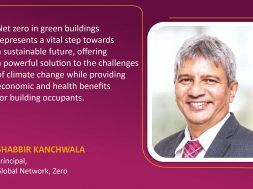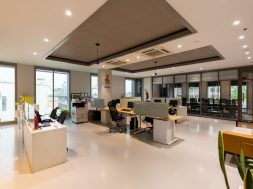The Net-Zero regime

Net-zero in green buildings represents a vital step towards a sustainable future, offering a powerful solution to the challenges of climate change while providing economic and health benefits for building occupants.
With the effects of climate change becoming increasingly severe, the idea of “Net-Zero” in green buildings has become essential to sustainable development. To minimise their overall environmental impact and cut carbon emissions, net-zero buildings generate as much energy as they need. This strategy encourages energy efficiency, cost savings, and a healthier living environment, in addition to aiding in the fight against global warming.
Fundamentally, a net-zero building produces as much energy as it consumes. To achieve this balance, a combination of renewable energy production, energy-efficient design, and cutting-edge technology that optimises and monitors energy use is usually used. Features that produce renewable energy on-site, such as solar panels, wind turbines, and geothermal energy systems, are frequently seen in green buildings with a net zero goal.
The notion of net zero is sometimes expanded to encompass waste and water management in addition to energy. For instance, a net-zero water building would not need to rely on outside water supplies because it would capture and treat all the water it needed. Analogously, a building with net-zero waste would divert all of its trash from landfills by recycling or repurposing it.

The cornerstone of a net-zero building is energy efficiency. Energy consumption must first be reduced using efficient design and technology to become net-zero. This entails installing energy-efficient lighting, heating, and cooling systems, utilising high-performance insulation and windows, and orienting the building to optimise natural light and heat.
Energy efficiency is further improved with the incorporation of smart building technologies. These systems ensure that energy is only utilised when and where it is needed by monitoring and adjusting energy use in real-time. For example, sensors can control heating and cooling according to occupancy levels and weather or switch off lights in empty rooms.
Energy efficiency lowers a building’s energy requirements; however, renewable energy production is essential to balance the energy used in the remaining areas. The most popular renewable energy source in net-zero buildings is solar power, which is produced by photovoltaic panels that convert sunlight into electrical power. Alternative renewable energy sources such as biomass, geothermal systems, and wind turbines can be used in areas where solar energy is less feasible.
Reducing reliance on fossil fuels and lowering carbon emissions are two benefits of integrating renewable energy systems into green buildings and helping them reach zero. Furthermore, these systems can offer energy resilience and security, especially in places with high energy prices or frequent power outages.
The transition of green buildings towards net zero provides noteworthy advantages for the environment and the economy. Energy-efficient technology and renewable energy systems can have hefty upfront costs, but these can be compensated for overtime by the money you save on energy bills. Furthermore, net zero buildings provide a buffer against future increases in energy costs as energy costs continue to climb.
From an environmental standpoint, net-zero buildings help to lessen greenhouse gas emissions, which in turn helps to slow down global warming. They also lessen the need for non-renewable resources and ease the burden on regional energy infrastructures. Additionally, green buildings with net-zero aim to promote greater indoor air quality and general occupant well-being, creating conditions for living and working that are healthier and more productive.
For more details, visit: https://www.globalnetworkforzero.com/
Cookie Consent
We use cookies to personalize your experience. By continuing to visit this website you agree to our Terms & Conditions, Privacy Policy and Cookie Policy.










